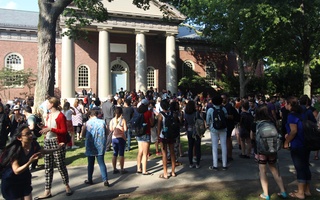Analogies may have received a bad name from being featured on so many devilish standardized exams, but there is a reason we learn about them in elementary school. Analogies take something that couldn’t previously be explained clearly and map it onto something that is already clearly understood by both parties.
The best analogies are simple. Take “intersectionality,” the term for an increasingly popular framework for activism, which says that in order to understand social and political phenomena, people must consider various human identities like race, gender, and sexuality not as separate, but as parts of a complexly tangled web.
That the term uses a basic comparison of intersecting identities to intersecting roads is simple enough to guess. Indeed, Kimberlé W. Crenshaw, a scholar credited with coining “intersectionality,” originally used the analogy to criticize a court’s dismissal of a black woman’s lawsuit of workplace discrimination. The court cited that the company in question hired both blacks and women, but Crenshaw argued that its decision didn’t take into account the woman’s intersectional identity.
As Crenshaw describes, the roads are identities, like race and gender, and the cars on the road are policies affecting those identities. Therefore, someone standing at such an intersection would be hit by traffic from both roads. For example, a black woman hit at the intersection of the roads representing blackness and femaleness would not be able to get help there. As a result, neither a race nor a gender “ambulance” could come along and help her, because they would mistakenly ask which road she belonged on, as if only one identity had jurisdiction over her.
Crenshaw’s point was that we needed to see things in terms of their intersections in order to explain them more effectively. To continue the analogy above, if someone gets hit by a car, it’s not their black side, or their straight side, or their female side, that gets hurt. Human beings cannot literally or metaphorically be divided by their different identities.
In the years since Crenshaw’s 1989 paper, “intersectionality” has taken on a life of its own. It usually shows up as an adjective in front of a movement, as in “intersectional feminism.” Supporters of intersectionality believe that a movement must stand for all the people under its umbrella. Intersectional feminists, for example, want more emphasis on issues that affect non-white, non-middle class women, since they contend that white, well-to-do women have traditionally been the main beneficiaries of feminism. Emphasizing the issues of underrepresented groups within a movement often includes advocating for issues not directly connected to the movement at hand. Thus intersectional feminists make a point to talk about things like LGBTQ rights and Black Lives Matter because, as the leaders of the 2017 Women’s March announced, “Our liberation is bound in each other’s.”
I think that these new uses of the term “intersectionality” are based on a different analogy of intersecting. This analogy positions the individual not as the one being hit and needing to explain what led to her predicament, but as the person with agency. The roads are movements, and each person places herself at the crossroads of the movements she supports.
As a result of this, in recent years, intersectionality has become much more disputed. For example, pro-life women were strongly discouraged from joining in the 2017 Women’s March even if they identified as feminists; seemingly Zionist lesbians were ejected from that year’s Chicago Dyke March. Now, a common complaint of intersectionality that it demands of its members an unfair level of ideological purity, across seemingly disparate issues. I think this type of complaint was bound to arise eventually based on the structure of the analogy itself.
In Crenshaw’s original analogy, the roads were neutral, factual givens, like race and gender, so one couldn’t choose where one stood. Now the roads themselves are political positions, so one can choose where to stand. However, wherever people are given choice, there are inevitably other people trying to take that choice away. These “intersectionality police,” so to speak, dictate where people should or should not stand—in the examples above, they essentially decreed that pro-life women can’t also be feminists and that lesbians can’t carry Jewish pride flags at a pride parade. But there are no objectively correct reasons for either stance.
We are all responsible for our own beliefs, and we should respect each other enough to assume that others have thought through their beliefs too. So it is no wonder that people being told that they have the wrong beliefs are questioning or outright rejecting “intersectionality.”
It is a blessing and a curse that the term “intersectionality” is vague enough to allow so many interpretations of its basic analogy. Crenshaw has admitted as much—while her theory is itself uncontroversial, the term itself has not been. Unlike on standardized tests, no interpretation of “intersectionality” is wrong. But it is also a stretch to say that all interpretations are equally good. It is increasingly clear where the imaginary intersections of intersectionality’s most extreme supporters are located—in a shrinking enclave shifting further and further left on the political map.
Michelle I. Gao ’21, a Crimson editorial editor, lives in Weld Hall. Her column appears on alternate Fridays.
Read more in Opinion
In Defense of the ArtsRecommended Articles
-
Two Centuries Ago University-Owned Ferries Carried Students to Boston--Omnibuses Later Were TransportersTo go into Boston nowadays, the Harvard student descends into the bowels of the earth, drops a dime into a
-
PRESSTeacher: "Who gave us this beautiful school?" Pupil: "President Roosevelt." Teacher: "Who keeps our roads so nice?" Pupil: "President Roosevelt."
-
No HeadlineCould be something in the way days are changing getting shorter a smile no longer working for us and we
-
STRONG TALKS AT UNION ON LIBERIAN CUSTOMSDr. R. P. Strong Hon. '16, professor in the Harvard Medical School, spoke last night in the Living Room of
-
 Act on a Dream Ramps Up During Trump Presidency
Act on a Dream Ramps Up During Trump Presidency













